 IST,
IST,
VI. The External Economy
International Developments
Merchandise
Trade
Invisibles and Current Account
Capital
Account
Foreign Exchange Reserves
External
Debt
India's external sector gained strength and resilience during the year. The current account balance remained in surplus for the third consecutive year, despite a surge in imports. Merchandise export growth was significantly higher than the annual target of 12 per cent and was accompanied by an acceleration in the growth of invisible earnings. Net capital flows during 2003-04 were the highest ever in spite of substantial pre-payments of bilateral and multilateral debt, Resurgent India Bonds (RIBs) redemption and lending to the IMF. The rising international investor confidence in the Indian economy was reflected in a surge of portfolio investment and revision of international credit ratings to investment grade, after a hiatus of around seven years. At the end of March 2004, India’s foreign exchange reserves (excluding gold) were the fifth largest among the emerging market economies and the sixth largest in the world (Chart 56).
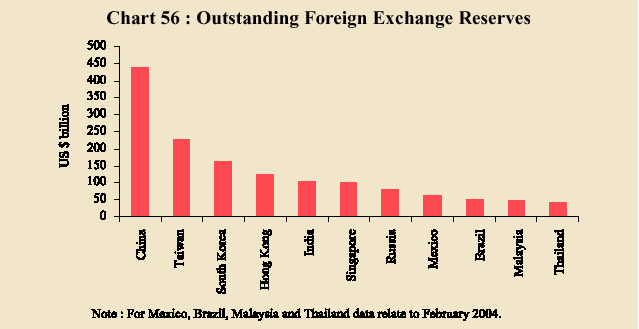
Signs of global recovery firmed up during 2003. In the US, economic activity was buoyed up by monetary and fiscal stimuli and aided by productivity gains. In the UK, output growth was above trend in the second half of 2003. The Asia-Pacific region continued to be the fastest growing region in 2003, led by China and India. In Japan, GDP rose in all quarters of 2003. The fourth quarter recorded a significant step-up of growth to 6.4 per cent (annualised) as domestic demand was augmented by exports. Activity in the euro area remained weak, held down by sluggish domestic demand. According to the IMF, global GDP growth is estimated to have increased from 3.0 per cent in 2002 to about 3.9 per cent in 2003 (Chart 57). World trade prices in US dollar terms recovered sharply, essentially reflecting depreciation of the US dollar against major international currencies and an upturn in the cycle for global commodity prices.
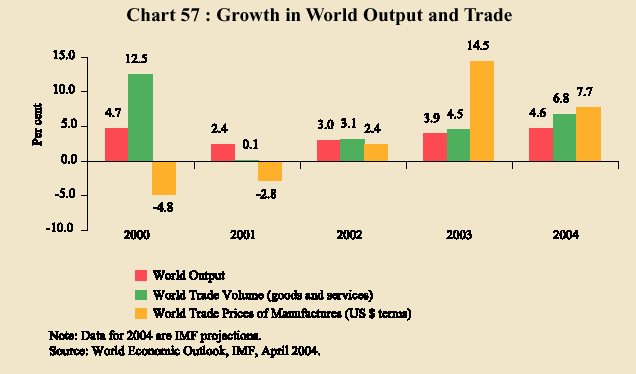
In advanced economies, long-term interest rates touched 40-year lows by mid-June 2003 reflecting the accommodative stance of monetary policy. In subsequent months, long-term rates increased in some countries such as the USA on signs of a pick-up in activity. Equity markets remained buoyant, benefiting from earnings growth, with many emerging markets posting double-digit gains. Improved domestic growth prospects coupled with low policy rates in advanced economies made emerging markets attractive to foreign investors. Sentiment towards emerging market economies (EMEs) was also boosted by a series of credit rating upgrades, mainly reflecting fiscal consolidation and increasing foreign exchange reserves. The upgrades were associated with narrowing down of spreads on bonds of most of the EMEs. Concerns about the US current account deficit weighed down on the US dollar which witnessed a cumulative depreciation by 16.5 per cent since September 2003.
Private capital flows to EMEs increased significantly during 2003, mainly on account of a marked rise in ‘other’ capital flows and a marginal decline in outflows under portfolio investment. On the other hand, direct investment inflows declined (Chart 58).
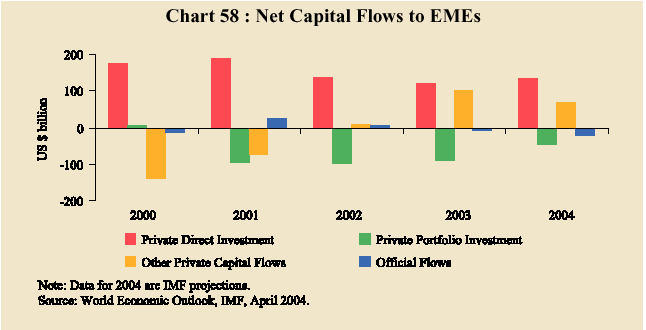
According to the IMF, global GDP growth is estimated to increase further to 4.6 per cent in 2004. This assessment is based on expectations of a reduction in geo-political uncertainties, policy stimulus in the pipeline and a gradual diminution of the after effects of the stock market bubble. The major risks to sustaining the recovery emanate from the imbalances arising out of the twin deficits of the US economy and the consequent possibility of a disruptive adjustment of the US dollar against the major currencies. In turn, these risks pose dangers of abrupt or unexpected increases in interest rates which could stifle investment and consumption and increase debt servicing.
Merchandise Trade
According to the Directorate General of Commercial Intelligence and Statistics (DGCI&S), India’s merchandise exports posted a growth of 17.1 per cent during 2003-04 benefiting from improved external demand conditions, the firming up of manufacturing activity domestically and favourable shifts in the policy mix for the external sector. The depreciation of the US dollar vis-a-vis other international currencies was reflected in a modest improvement in unit value realisation even as the volume growth of exports slowed relative to the preceding years.
The export performance was underpinned by a strong growth in engineering goods, chemicals and related products and petroleum products. Exports of engineering goods accelerated with contributions from all major constituents –iron and steel, machinery, automobiles and electronic goods. The automobile sector emerged as a leading exporter, attesting to the rising technology content of India’s exports. Indian steel exporters turned out to be among the lowest cost producers in the world. On the other hand, exports of traditional manufactured items such as textiles posted a decline.
The decline in primary products was mainly in respect of traditional items (tea, basmati rice, spices, cashew, marine products and ores and minerals). Within primary products, the export basket is undergoing shifts. Exports of non-traditional items (fresh fruits and vegetables, wheat, dairy products, processed vegetables and poultry products) showed a sharp increase (Table 22).
Table 22 : Merchandise Exports: April-December
| Commodity Group | US $ million | Variation (per cent) | ||||
|
2002-03 |
2003-04 |
2002-03 |
2003-04 | |||
|
1 |
2 |
3 |
4 |
5 | ||
| 1. |
Primary Products | 6,459 |
6,393 |
25.1 | -1.0 | |
| 2. |
Manufactured Goods | 29,206 |
33,291 |
21.3 | 14.0 | |
| Of which: | ||||||
| a. |
Chemicals and Related Products |
5,445 |
6,452 |
23.5 | 18.5 | |
| b. |
Engineering Goods | 6,415 |
8,418 |
26.7 | 31.2 | |
| Of which: | ||||||
| Metals |
1,365 |
1,645 |
14.2 | 20.5 | ||
| Machinery and Instruments | 1,487 |
1,928 |
19.8 | 29.7 | ||
| Transport Equipments | 893 |
1,327 |
25.6 | 48.5 | ||
| Iron and Steel | 1,200 |
1,668 |
80.3 | 39.0 | ||
| Electronic Goods | 917 |
1,222 |
2.8 | 33.3 | ||
| c. |
Textiles | 8,044 |
7,958 |
13.8 | -1.1 | |
| d. |
Gems and Jewellery | 6,531 |
7,789 |
31.1 | 19.3 | |
| 3. |
Petroleum Products | 1,687 |
2,473 |
7.3 | 46.6 | |
| 4. |
Total Exports |
38,066 |
43,523 |
19.9 |
14.3 | |
| Source: DGCI&S. | ||||||
In terms of destinations, Asian countries continued to record a robust growth although at a more moderate pace than in 2002-03. Absorption was lower in key markets such as the US and Japan. Export growth to European Union was broadly of the same order as in the previous year.
Merchandise imports recorded a sharp rise of 25.3 per cent in US dollar terms during 2003-04. This was mainly on account of a surge in non-oil imports, reflecting the pick-up in industrial activity. Oil imports increased sharply due to hardening of international crude oil prices from an average of US $ 27.6 per barrel in 2002-03 to US $ 29.1 per barrel in 2003-04 as well as shortfalls in domestic crude production. Rising domestic demand for capital goods, industrial raw materials and intermediate goods boosted non-PoL import growth, which again is symptomatic of the resurgence in industrial activity. Imports of gold and silver increased sharply, partly reflecting a base effect (these imports had declined in the corresponding period of the previous year) (Table 23). As regards the geographical distribution of imports, Asia emerged as the key source followed by the USA and Japan.
Table 23 : Merchandise Imports: April-December
| Commodity Group |
US $ million |
Variation (per cent) | ||
| 2002-03 |
2003-04 |
2002-03 |
2003-04 | |
|
1 | 2 |
3 |
4 |
5 |
| 1. POL |
12,768 |
14,706 |
19.0 | 15.2 |
| 2. Edible Oils |
1,330 |
1,932 |
25.3 | 45.3 |
| 3. Iron and Steel |
708 | 1,072 |
16.8 | 51.6 |
| 4. Capital Goods |
9,057 | 12,185 |
33.9 | 34.5 |
| 5. Pearls, Precious and Semi-Precious Stones | 4,504 |
5,005 |
40.3 | 11.1 |
| 6. Chemicals |
2,221 |
2,859 |
6.7 | 28.8 |
| 7. Gold and Silver |
3,455 |
4,961 |
-12.4 |
43.6 |
|
8. Total Imports |
44,553 |
55,432 |
15.8 |
24.4 |
|
Memo: | ||||
| Non-oil imports excluding gold and silver | 28,329 |
35,765 |
19.0 | 26.2 |
| Source: DGCI&S. | ||||
India’s trade deficit, based on DGCI&S data, nearly doubled to US $ 13.7 billion during 2003-04 driven up by the expansion in imports (Chart 59).
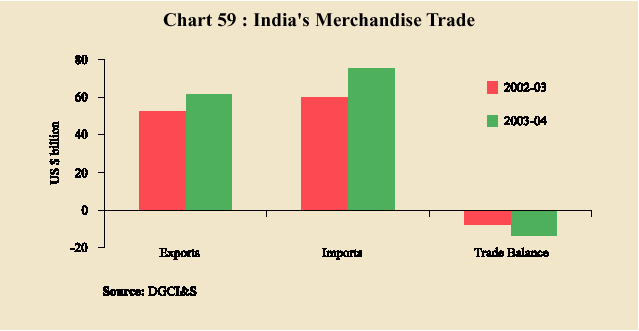
Invisibles and Current Account
As in the preceding two years, the invisible surplus was able to fully offset the merchandise trade deficit. The surplus in the invisible account increased from US $ 12.6 billion in April-December 2002 to US $ 18.2 billion in April-December 2003, mainly on account of higher receipts from software services, private transfer receipts and tourism earnings. A revival of international interest in India as a tourist destination was reflected in an increase of 18.5 per cent in tourist arrivals
in 2003-04. Exports of software and IT-enabled services have been growing at an average rate of 46 per cent since the mid-1990s. Despite the global slowdown, Indian IT industry raised its share in global IT-spending from about one per cent at the end of the 1990s to about three per cent currently. India is one of the most preferred destinations for outsourcing of IT services.
With buoyant invisible receipts, the current account surplus increased to US $ 3.2 billion during April-December 2003 from US $ 2.9 billion during the corresponding period of the previous year (Chart 60).
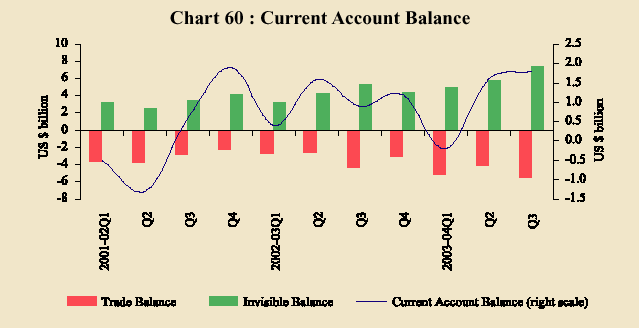
Capital Account
In the capital account, there were unprecedented two-way movements. Foreign institutional investors displayed a strong appetite for India vis-a-vis other EMEs, drawn by attractive valuations (Table 24). Portfolio investment inflows turned out to be the highest in any year since the opening of Indian stock exchanges to FIIs in 1992-93. Equity investments continued to be the pre-dominant component; however, FII investment in debt instruments rose strongly too, exceeding the cap of US $ 1 billion in 2003-04, an all-time peak. Issuances by Indian corporates in overseas stock exchanges were subdued in relation to 2002-03, with a preference for convertible bonds over depository receipts.
Table 24 : Foreign Portfolio Investment Flows
| (US $ billion) | ||||
| Country |
Portfolio Inflows |
Price-Earnings | ||
| 2001 |
2002 |
2003 |
Ratio (Per cent) | |
| 1 |
2 |
3 |
4 |
5 |
| Hong Kong |
-1.2 |
-0.9 |
-1.4 |
17.8 |
|
Chile | 1.4 |
1.3 |
1.0 |
18.6 |
|
India | 2.0 |
1.0 |
11.4 |
14.3 |
|
South Korea |
12.2 |
4.9 |
14.2 |
14.6 |
|
Philippines |
1.4 |
2.3 |
1.1 |
16.8 |
|
Thailand |
-0.6 |
-0.7 |
0.3 |
9.0 |
| Note: 1.Data
for China, Chile, Hong Kong and Philippines for 2003 are up to | ||||
During 2003-04, foreign direct investment into India at US $ 4.5 billion fell marginally short of the previous year’s level of US $ 4.7 billion. The services sector was the largest recipient of FDI inflows. Mauritius remained the largest source of FDI flows to India followed by the USA, the Netherlands and the UK.
Non-resident Indians (NRIs) also shared in the international investor confidence in India. During 2003-04, net inflows into NRI deposit schemes at US $ 3.6 billion surged above US $ 3.0 billion recorded in 2002-03. RIB redemptions produced one-off effects in October 2003 as switches into deposit accounts occurred. Thereafter, net inflows slowed down to an average of US $ 55 million per month as further reduction in the interest rate ceiling on NRE scheme to LIBOR plus 25 basis points in October 2003 (and to LIBOR only effective April 17, 2004) took effect. Other banking capital was lower at US $ 2.1 billion during April-December 2003 as compared with US $ 4.4 billion during the corresponding period of the previous year. The build-up of banks’ overseas foreign currency assets and borrowings in the first half of the year on account of RIB redemption was partly offset by a subsequent drawdown.
Medium- and long-term debt flows were impacted by pre-payments of official debt (US $ 2.0 billion) and redemption of RIBs (US $ 5.2 billion) till end-December 2003. There was a further pre-payment of official debt of US $ 1.8 billion during January-March 2004. As a consequence, net outflows were recorded under external assistance and external commercial borrowings, despite some pick-up in demand for ECBs in line with stronger industrial activity and interest rate differentials (Table 25).
Table 25 : Capital Flows: April-December
| (US $ billion) | ||
| Item |
2002-03 |
2003-04 |
|
1 |
2 |
3 |
| 1. Foreign Direct Investment | 2.8 |
2.5 |
|
2. Portfolio Investment |
0.4 |
7.6 |
|
3. Non-resident (NRI) deposits |
2.4 |
3.5 |
|
4. Banking Capital, excluding NRI deposits |
4.4 |
2.1 |
|
5. External Commercial Borrowings |
-2.0 |
-3.7 |
|
6. Short-term Trade Credits |
0.4 |
2.4 |
|
7. External Assistance |
0.1 |
-1.8 |
|
8. Total |
10.5 |
17.3 |
The surpluses in the capital and current accounts led to an overall balance of payments surplus of US $ 20.8 billion during April-December 2003.
Foreign Exchange Reserves
India’s foreign exchange reserves including the reserve position in the IMF stood at US $ 113.0 billion on March 31, 2004, recording an unprecedented accretion of US $ 36.9 billion during 2003-04. The increase in reserves was almost entirely on account of foreign currency assets. The reserve position in the IMF increased by US $ 639 million mainly on account of lendings under the IMF's financial transaction plan. Out of the total RIB redemption of US $ 5.2 billion, US $ 2.8 billion was paid out of the Reserve Bank’s forward foreign currency receivables and the balance US $ 2.4 billion out of its foreign exchange reserves. The reserves were also drawn down by pre-payments of official debt, as referred to earlier. Inclusive of reserve position in the IMF, foreign exchange reserves amounted to US $ 118.5 billion at the end of April 2004.
In terms of trade related reserve adequacy indicators, India’s foreign exchange reserves at about 17 months of imports are higher than other EMEs in Asia. India's ratio of reserves to short-term debt comfortably satisfies the adequacy criterion vis-à-vis comparator countries. In terms of overall external debt and total external liabilities, India’s reserves are broadly adequate. As regards the money-based indicators, India is far below the East Asian economies, indicative of the vulnerability of economic activity to any possibility of massive capital outflows. Furthermore, the ratio of India’s reserves to GDP is the lowest among the major EMEs of Asia (Table 26).
Table 26 : Reserve Adequacy Indicators
| (Per cent) | |||||
| Criteria |
India |
China |
Korea |
Singapore |
Hong Kong |
|
1 | 2 |
3 |
4 |
5 |
6 |
| Trade-related Indicators* | |||||
| Import cover (months) |
17.3 | 12.8 |
11.0 | 9.5 |
6.4 |
|
Current payments cover |
13.2 | 12.4@ |
8.8 | 6.4@ |
5.2 |
|
Debt-related Indicators# | |||||
| Reserves to external debt |
90.8 | 126.7 |
77.2 | 56.9 |
32.9 |
|
Reserves to short-term external debt |
1521.7 |
490.9 |
280.7 |
81.1 | 48.8 |
| Reserves to total external liabilities | 46.9 |
NA | 43.3 |
29.3 | 16.3 |
| Money-based Indicators* | |||||
| Reserves to broad money |
24.2 | 16.3 |
35.2 | 88.3 |
30.0 |
|
Reserves to reserve money |
111.0 |
66.0 | 478.8 |
833.0 |
328.2 |
|
Macro Indicators@ | |||||
| Reserves to GDP |
17.6* |
23.5 | 24.1 |
91.5 | 69.3 |
| *
Data pertain to end-March 2004. Source
: 1. International Financial Statistics, IMF. | |||||
External Debt
India’s external debt increased by US $ 7.4 billion (7.1 per cent) during April-December 2003 to reach US $ 112.1 billion at end-December 2003. NRI deposits and short-term debt were the major contributors to the rise in external debt (Chart 61).
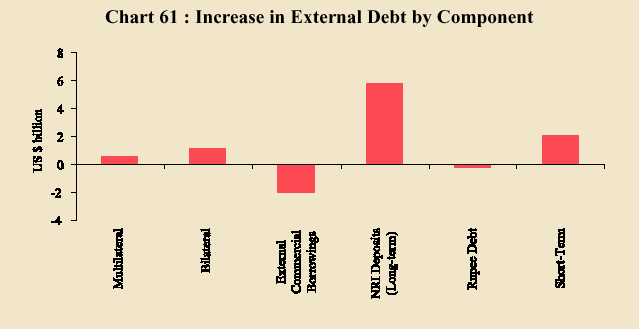
The increase in debt under NRI deposits reflected conversion of maturing non-repatriable deposits (hitherto not part of external debt) into repatriable schemes and their consequent inclusion under external debt. Key indicators pointed to enduring sustainability of external debt (Chart 62).
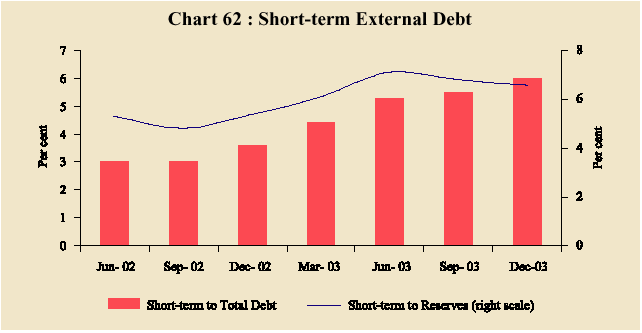
Page Last Updated on:

















